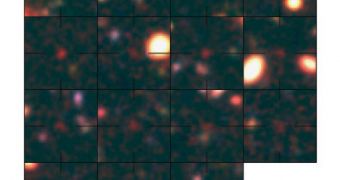According to the standard cosmological model, the Big Bang – the event that created our Universe – took place about 13.7 billion years ago. After that, the Cosmos began expanding and producing all types of structures, which would eventually differentiate in things we know today, such as galaxy, clusters and black holes. Some of the first galaxies to have ever shone their lights in the darkness were recently imaged by a team of astronomers, wielding the wide-field camera of the 8.3-meter Subaru Telescope, in Hawaii. They are estimated to have formed when the Universe was just some 787 million years old, Space reports.
Immediately after it exploded into being, the Cosmos was somewhat a mess. There was no light produced inside it, and therefore astronomers cannot use modern telescopes to find residual photons from that time. But some 400,000 years after the Big Bang, things changed. The mess cooled down, allowing for the electrons and protons in the mix to combine together in what would become the first hydrogen atoms, sporting a neutral charge. The Universe got a lot clearer, and the first galaxies began to form. This age, spanning until1 billion years after the explosion, is known as the “Reionization Epoch.” Once it concluded, the first galaxies were already in place.
However, the structures that were recently observed most likely formed some 220 million years or so before the end of the Universe's oldest known stage. The issue that astronomers have been struggling to determine is precisely when the Reionization Age began, as in, when the first light, stars and galaxies formed. In order to help answer this question, Carnegie Observatories experts, led by Masami Ouchi, used a complex technique to scout the skies.
“We look for 'dropout' galaxies. We use progressively redder filters that reveal increasing wavelengths of light and watch which galaxies disappear from or 'dropout' of images made using those filters,” Ouchi explains. He adds that each galaxy's specific wavelength can be a clear indicator of the structures age and distance from our planet. The work the experts made had more galaxies to work on than any previous study, because the scientists chose to investigate an area of the sky 100 times larger than ever before. “Plus, we were able to confirm one galaxy's age. Since all the galaxies were found using the same dropout technique, they are likely to be the same age,” he says.
“We were really surprised that the rate of ionization seems so low, which would constitute a contradiction with the claim of NASA's WMAP satellite. It concluded that reionization started no later than 600 million years after the Big Bang. We think this riddle might be explained by more efficient ionizing photon production rates in early galaxies. The formation of massive stars may have been much more vigorous than in today's galaxies. Fewer, massive stars produce more ionizing photons than many smaller stars,” Ouchi concludes.

 14 DAY TRIAL //
14 DAY TRIAL //